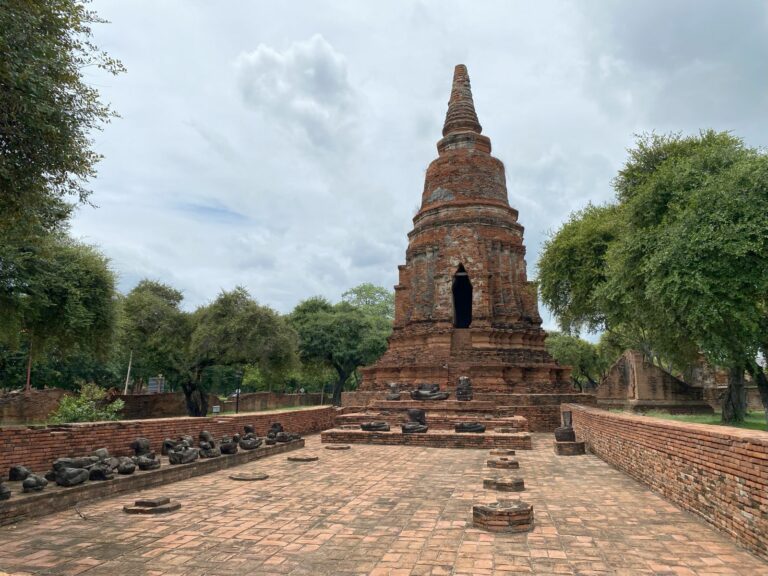Where to Go in Southeast Asia When You’re Too Hot
Traveling through Southeast Asia is an incredible experience, but let’s be honest—sometimes the heat can be overwhelming. If you’re not used to it, the intense sun and unrelenting humidity can literally feel like it’s draining your life force.
As much as I love wandering through busy cities and exploring ancient ruins, eventually the heat gets to be too much and all I want is a break. Air conditioning is nice, but even nicer is finding a place where I can walk around outside without sweating through my clothes.
If you’ve ever found yourself thinking the same, you’re in luck! I’ve discovered some amazing spots across Southeast Asia that let you escape from the heat for a bit.
In this post, I’ll go over five locations where the average temperatures are low enough to be pleasant even during the day. Whether you’re into exploring highland towns, trekking through misty forests, or simply relaxing by the beach with a gentle sea breeze, this list has you covered!
Just Gone Wandering is supported by readers! This post contains affiliate links. If you click on a link and buy something, I get a small percentage at no extra cost to you. Your support helps keep this blog running— thank you! Read full disclosure here.
Cameron Highlands, Malaysia
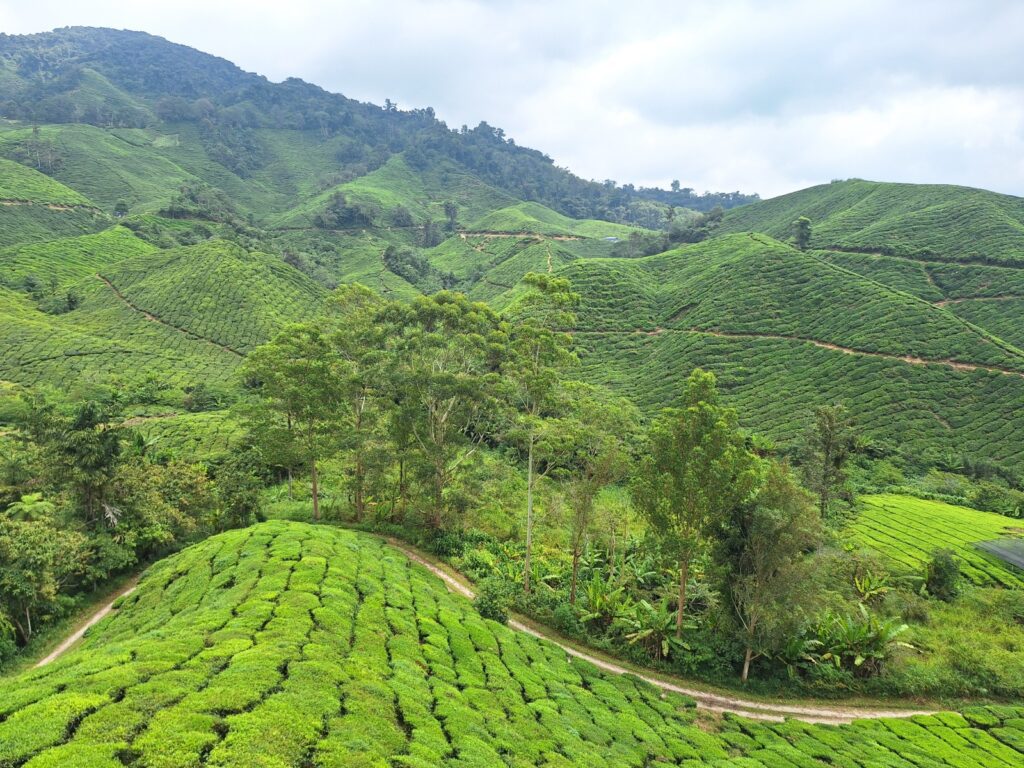
The Cameron Highlands is one of Malaysia’s most popular vacation destinations, located at an altitude of around 4,900 feet (1,500 meters) above sea level. It’s known for having a cool, temperate climate, much lower than the rest of the country.
For instance, when I visited this year in July, Kuala Lumpur was already up to OVER 100°F with humidity. Horrible! In comparison, Tanah Rata (in the Cameron Highlands) was averaging a nice 76°F or so with humidity. Lovely!
The huge difference in temperature is why both locals and tourists head up into the mountains when the heat gets to be too much. That, plus there’s some wonderful nature-centered activities you can do while you’re there!
Things to Do in Cameron Highlands
Mossy Forest: The oldest forest in Malaysia and unique for its mossy, dense vegetation. Honestly feels like something from a fantasy book.
Related: Half-Day Tour of Cameron Highlands (Review)
Tea Plantations: Cameron Highlands is famous for its expansive tea plantations, particularly the BOH Tea Plantation. Visitors can tour the plantation, learn about the tea-making process, and enjoy a fresh cup of tea in one of the on-site restaurants.
Strawberry Farms: Visitors can pick their own strawberries or enjoy freshly made strawberry treats like jams, ice cream, and desserts.
Hiking: The Cameron Highlands offers several trails ranging from easy walks to more challenging hikes. The cooler weather makes hiking much more comfortable compared to lowland areas.
📲 Traveling through multiple countries? Grab the Asialink regional eSIM from Airalo. New users, use promo code NEWTOAIRALO15 to save 15%. Existing users, use promo code AIRALOESIM10 to save 10%!
Dalat, Vietnam
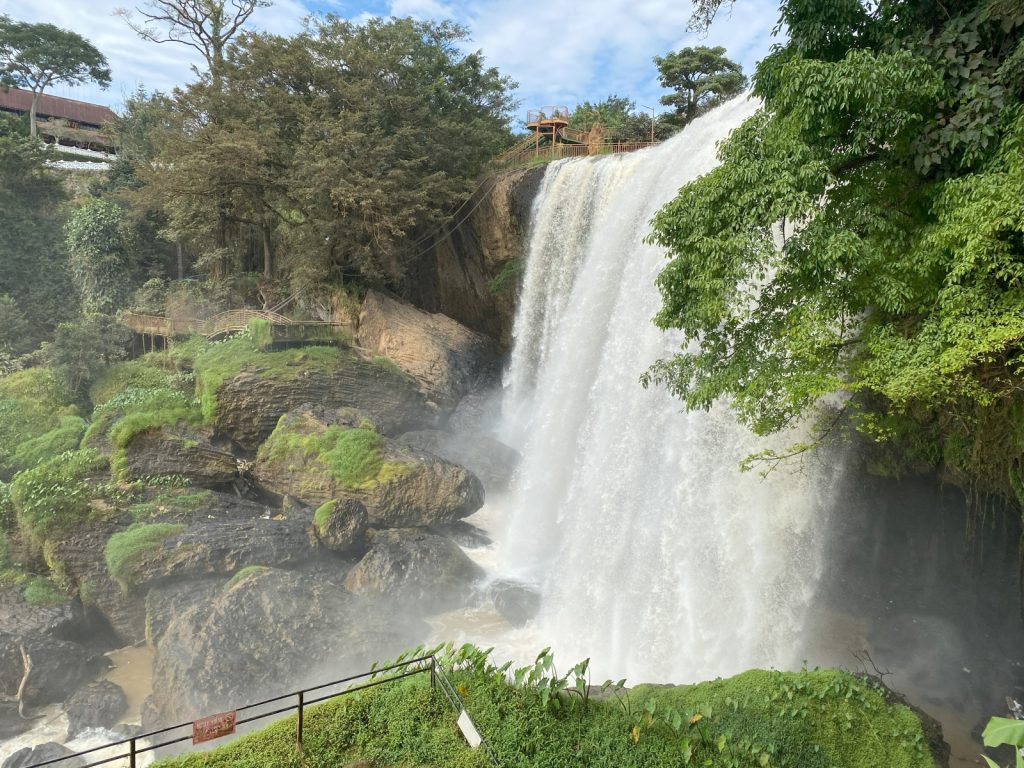
Dalat, located in the Central Highlands of Vietnam, is often referred to as the “City of Eternal Spring” due to its mild and pleasant climate year-round. Sitting at an elevation of around 4,900 feet (1,500 meters) above sea level, Dalat is much cooler than (most of) the rest of Vietnam.
Getting there isn’t the easiest—this is one of the night bus experiences I did NOT enjoy—but once you get up there you’ll be so thankful you did it. It’s a really nice town and so relaxed compared to the bigger cities. I only meant to stay a few days but I extended my stay last year just to hang out in the cool air a bit longer.
The average day temperatures in Dalat range from 59°F to 75°F, significantly lower than Hanoi and Ho Chi Minh City get. It’s so cool that the hotels don’t even bother having air conditioning. They don’t need it!
Things to Do in Dalat
Dalat Flower Gardens: Known for vibrant floral displays, the Dalat Flower Gardens show a wide variety of flowers including roses, orchids, and hydrangeas. Dalat is known for its flowers, and the flower-growing industry is huge here.
Crazy House (Hang Nga Guesthouse): Designed by Vietnamese architect Đặng Việt Nga, this building is famous for its unconventional, surreal design resembling a giant tree. You can even book a night’s stay!
Boating on Xuan Huong Lake: Visitors can rent paddle boats and explore the calm waters of Xuan Huong Lake while enjoying cool breezes and scenic views.
Related: Day tour in Dalat, Vietnam (Review)
Ha Giang, Vietnam
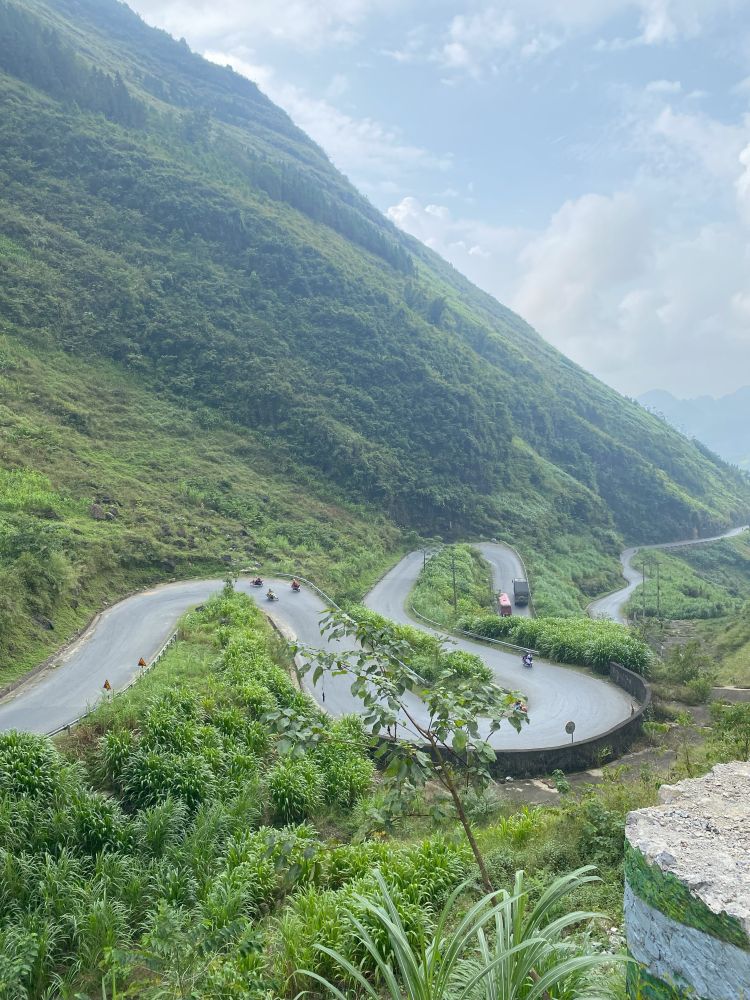
Located in the far north, close to the Chinese border, Ha Giang is the entrance point to a region of rugged mountains, winding roads, and breathtaking landscapes.
The best part? Because of its high elevation, it’s much cooler than other parts of Vietnam. When I did the Ha Giang Loop motorcycle tour, I actually had to wear LAYERS because it was so cold. And unlike the lowland areas where humidity makes the air stifling, Ha Giang offers fresh mountain air. Definitely a nice change of pace!
Nearby Sapa is also a good place to go, and it has more of a rural countryside vibe which is appealing after visiting busy cities like Hanoi and Bangkok.
Things to Do in Ha Giang
Motorbiking the Ha Giang Loop: This iconic experience is a must-do for adventurous travelers. The loop takes you through some of Vietnam’s most amazing landscapes, with plenty of cool breezes and breathtaking scenery to enjoy along the way. (And sometimes rain.) Read about my experience on the Loop here.
Local Ethnic Villages: Ha Giang is home to several ethnic minority groups, each with their own distinct culture and traditions. You can visit some as part of a tour or go on your own to explore the local shops and crafting communities.
Trekking in the Karst Plateau: For those who love to hike, the Dong Van Karst Plateau offers incredible trekking opportunities. The cooler climate makes it possible to enjoy long walks without feeling drained by the heat.
Chiang Mai, Thailand (During Winter)
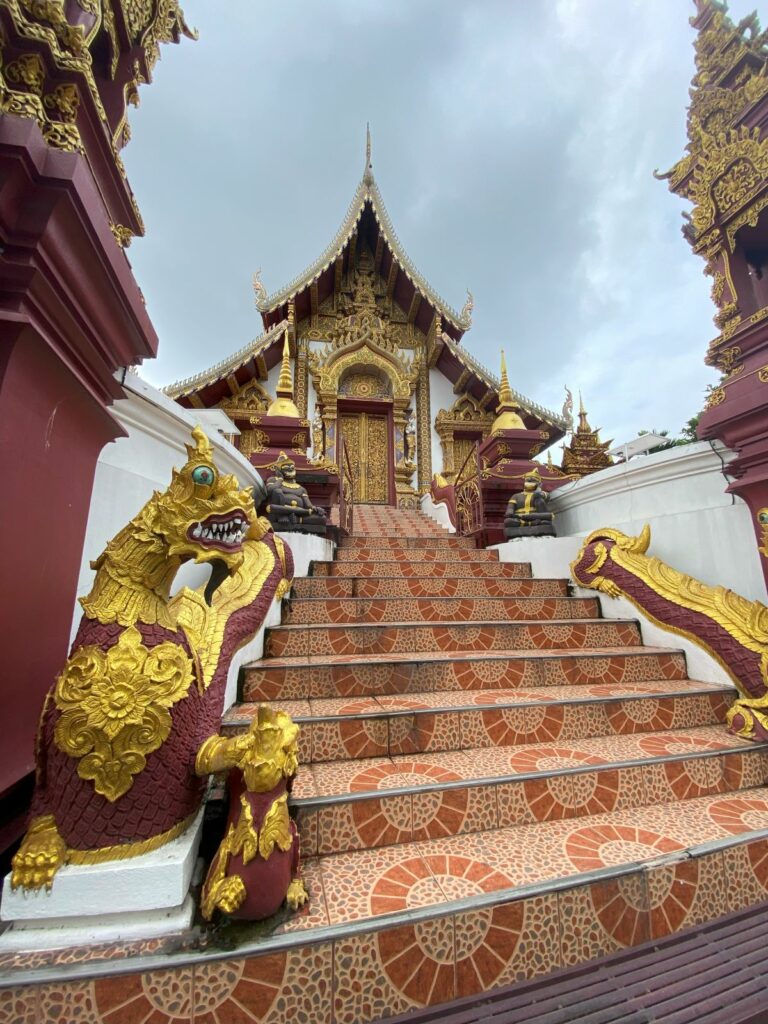
Chiang Mai, located in northern Thailand, is known for its rich cultural heritage, ancient temples, and fun night markets. It’s also a VERY popular place for digital nomads and expats, so it’s busy year-round. The busiest time is during the winter (November to February), when cooler temperatures make it much more comfortable than the rest of Thailand.
To compare: Chiang Mai typically gets winter temperatures between 59°F to 82°F. Meanwhile, Bangkok is riding somewhere like 79°F to 95°F. And that’s before factoring in humidity!
While not the coolest place on this list, there are other benefits to visiting Chiang Mai. There’s a thriving digital nomad community, lots of great cafes to visit, and a wonderful town to explore. I had a great time wandering around looking at the interesting buildings and street art, and the locals are so nice! I ended up staying in Chiang Mai for a few weeks longer than expected and don’t regret it at all.
Things to Do in Chiang Mai
Doi Inthanon National Park: Home to Thailand’s highest peak, Doi Inthanon National Park is a must-visit for nature lovers. The park offers cool air and great views, along with beautiful waterfalls. The summit of Doi Inthanon, which stands at 8,415 feet (2,565 meters), can be particularly chilly, making it a perfect escape from the heat.
Old City Temples: Chiang Mai’s Old City is filled with historic temples, including Wat Phra Singh, Wat Chedi Luang, and Wat Chiang Man. The cooler winter weather makes exploring inside the city walls much more comfortable, even during the day.
Night Markets: Chiang Mai is famous for its night markets, such as the Sunday Walking Street and the Night Bazaar. The cooler evenings during winter make it an ideal time to stroll through these markets, shop for local crafts, and sample street food.
Related: Street Art Spotlight: Chiang Mai, Thailand
Bali, Indonesia
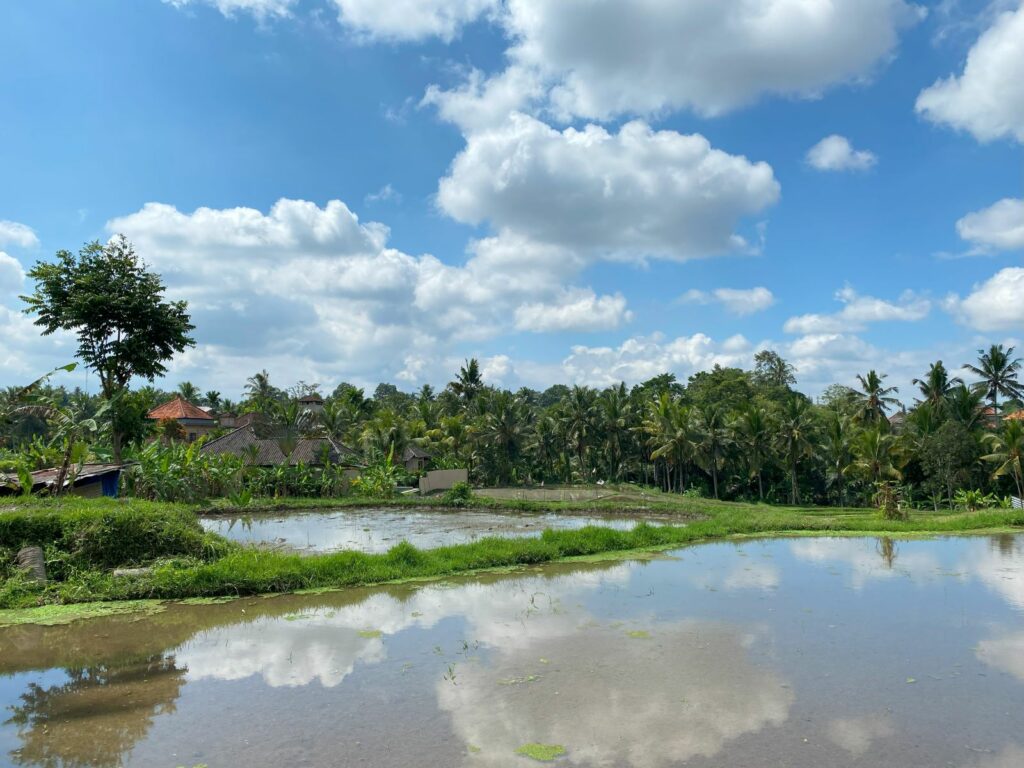
Bali is Indonesia’s most famous island, to the point where it’s running into some overtourism problems. It’s a tropical paradise known for its stunning beaches, Balinese Hindu culture, and lush landscapes—and lots and lots of tourists.
Bali is maybe the busiest location on this list, and it’s busy year-round. If you want to spend a significant amount of time here, be sure to book your accommodation early.
Anyway, let’s talk temperature! While Bali generally enjoys warmer weather than other places on this list, certain areas on the island are cooler than others. For instance: the beachy areas like Sanur and Nusa Dua! The breeze coming off the ocean makes Bali feel considerably cooler than the rest of Indonesia, and it’s very refreshing.
Or if you go up into the highlands, like Ubud, you can also catch some of that cool breeze. I really liked Ubud and though the center of town is a bit congested, if you go into the outskirts you can find some amazing rice fields and more rural-looking places.
Things to Do in Bali
Ubud: Ubud is known for its rich cultural heritage, rice terraces, and Sacred Monkey Forest. Watch a local dance, eat delicious food, and explore the markets for new clothes and trinkets to take home! I found Ubud very charming, and highly recommend stopping by as an alternative to beach towns.
Mount Batur: This active volcano, located in the northeastern part of Bali, is a popular destination for trekking. The climb to the summit is particularly popular at sunrise, when the cooler, early-morning temperatures make the trek more manageable.
Relaxing on Breezy Beaches: Bali’s coastal areas, like Sanur and Nusa Dua, offer a more tranquil beach experience with cool winds coming off the water. Visitors can enjoy water sports, beachside dining, or simply relax under the shade of a palm tree.
Final Thoughts
Traveling through Southeast Asia doesn’t mean you have to sweat it out all the time. There are plenty of places where you can catch a break from the heat and still have an amazing adventure on the Banana Pancake Trail.
So, next time you’re feeling just a little too hot, remember these spots! If you’ve found other hidden gems in Southeast Asia that help you beat the heat, I’d love to hear about them. Drop a comment with your suggestions!
Save to Pinterest
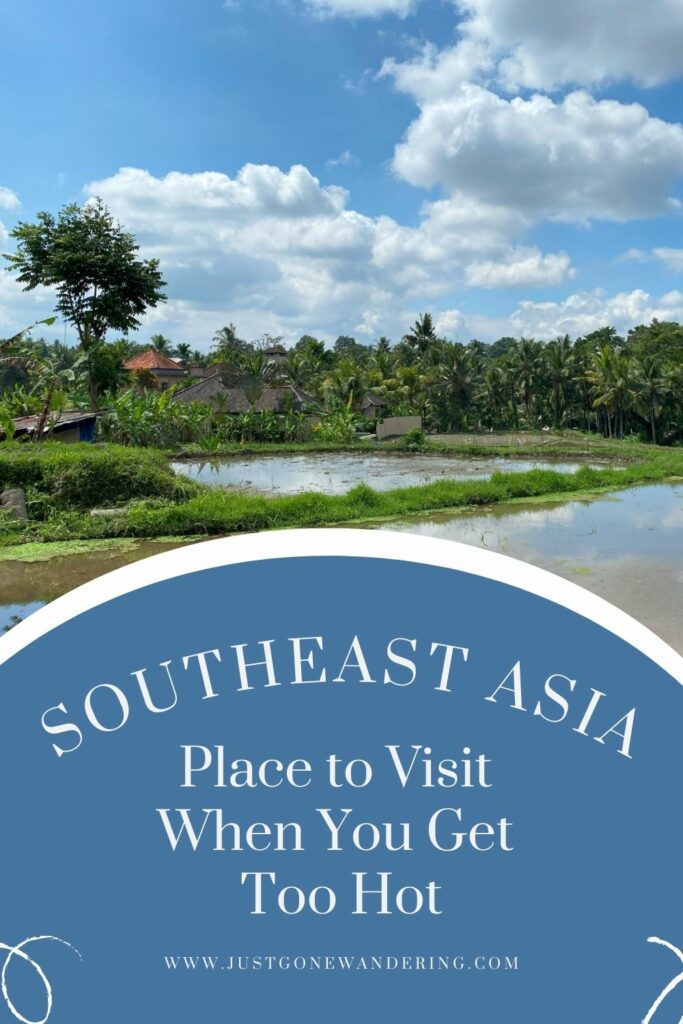

Explore More
Solo Female Travel
- Top 5 Countries for First-Time Solo Travelers to Visit
- Going on Your First Solo Trip: Tips for First-Time Travelers
- Safety tips for solo female travelers
- Should I tell people I’m alone? and other questions from solo female travelers
- How to make friends while traveling solo
- How to Book a Group Day Tour as a Solo Traveler
- Best Facebook Groups for Solo Female Travelers
- How to Get Great Photos of Yourself While Traveling Solo
Nomad Living
- How to Plan a Year of Full-time Travel
- Packing List for Perpetual Travel (Solo Female Cozy Budget Style)
- Backpack vs. Suitcase for Long-Term Travel
- How to keep in contact while traveling abroad
- The BEST WhatsApp Travel Group Chats
- 90+ Active Facebook Groups for Travelers
- Where to Stay Besides Hotels When Traveling Long-Term
- Travel kitchen essentials | Hotel cooking
- Best Resources for Long-Term Travel
Best Travel Resources
- 👩💻Stay organized with the Deluxe Travel Planner Spreadsheet
- 🛌Search Hostelworld for budget stays
- ✈️Search SkyScanner for discounted flights around the world
- 😺Join TrustedHousesitters and do petsitting in exchange for accommodation
- 💳Carry Chase Sapphire Preferred for a travel-friendly credit card
- 📱Use Airalo for eSIMs around the world
- 🚙Check DiscoverCars for international car rentals
- 👩💻Snag ExpressVPN to stay safe while browsing the web
- 🧑⚕️Sign up with VisitorsCoverage for trip insurance


